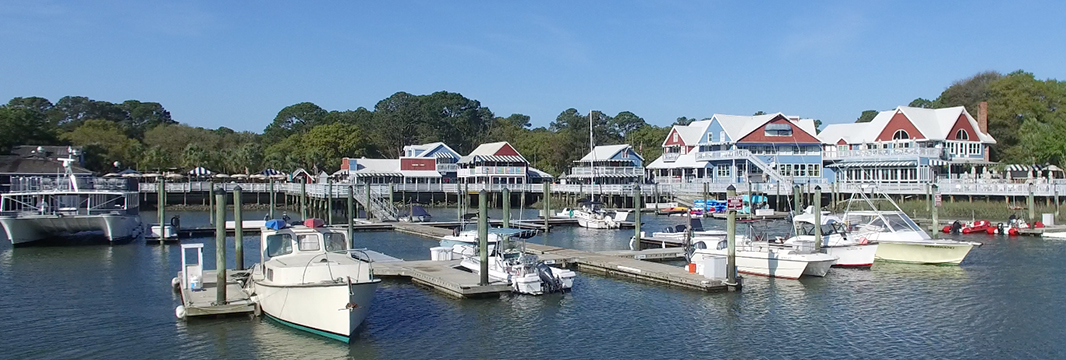
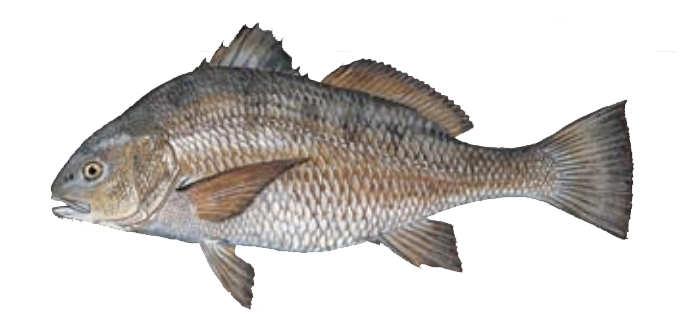
Black drum are inshore bottom fish. They favor sandy bottoms in salt or brackish waters near jetties, breakwaters, bridges, pier pilings, clam and oyster beds, channels, estuaries, bays, high marsh areas, and shorelines. They are common in all inshore and shallow coastal waters year- round, but are most abundant February through July.
Deep-bodied fish, silvery-gray in color. Young fish with four or five black vertical bars on sides that disappear with age. Body scales large and comblike, lateral line extending to hind margin of tail fin. Mouth inferior and nearly horizontal. Chin with 10 to 13 pairs of small barbels along inner edges of lower jaw.

The black sea bass is a bottom-dwelling species found around wrecks, reefs, piers, and jetties, as well as over beds of shells and rock. They prefer warmer waters, living offshore in winter and moving inshore during the spring.
Body color very dark. Preopercle finely serrated without a strong spine or spiny lobe, opercle with three flat spines. Dorsal fin single, notched with 10 spines and 11 soft rays. Tail fin rounded, often with a single upper ray elongated in adults.
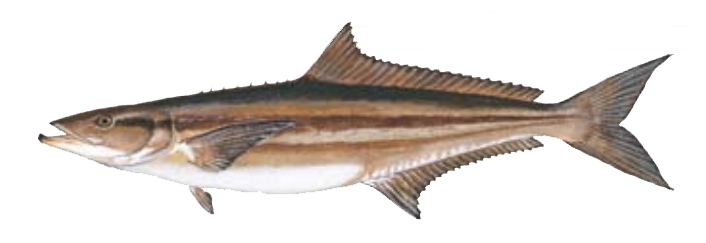
Cobia can be found in shallow continental shelf waters, and often congregate along reefs and around buoys, pilings, wrecks, anchored boats, and other stationary or floating objects. They are also found over mud, gravel, and sand bottoms, as well as natural and artificial reefs at depths of up to 60 feet.
Body elongated, back and sides dark brown with two sharply defined silvery bands, belly yellowish. Head broad and depressed. Mouth large and terminal. First dorsal fin with seven to nine short and strong isolated spines not connected by a membrane, second dorsal long with 27 to 33 rays. Upper lobe of tail fin longer than lower lobe.
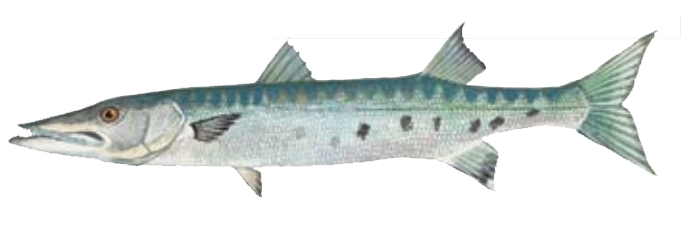
Young great barracuda live in inshore areas, while adults are found from inshore channels to the open ocean. They are found in bays, inlets, and coastal rivers where saltwater and freshwater meet, as well as around reefs, wrecks, piers, and sandy or grassy flats. They prefer shallow areas and appear to move inshore in summer and offshore in fall and winter.
Body elongated, steel gray above with dark bars on upper sides and several inky blotches of various sizes and position on posterior portion of lower sides. Large head with a long, pointed snout. Mouth superior with strong, pointed teeth of unequal size in both jaws. Area between eyes flat to concave.
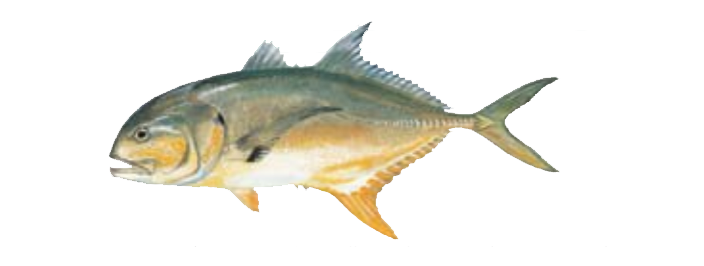
Crevalle jack can tolerate a wide range of salinities. They inhabit coastal brackish waters, and may go up rivers. They are regularly found over inshore reefs, and in harbors and protected bays from May through October and are common in depths up to 130 feet.
Body greenish to bluish above and silvery-white below. Juveniles often have five dark bars on body. Fins yellowish with a large, oval, black spot on the pectoral fins. Chest lacks scales except for a small patch in front of the pelvic fins. First rays of second dorsal fin and anal fin greatly elongated..

King mackerel are primarily an openwater, migratory species, preferring warm waters. They are often found around wrecks, buoys, reefs, ocean piers, inlets, and other areas where food is abundant, but they tend to avoid highly turbid waters.
Back iridescent bluish-green, sides silver, first dorsal fin lightly and uniformly pigmented with 14 to 16 spines. Lateral line abruptly curves downward below second dorsal fin. Snout much shorter than rest of head, maxilla exposed becoming vertical behind posterior margin of eye.
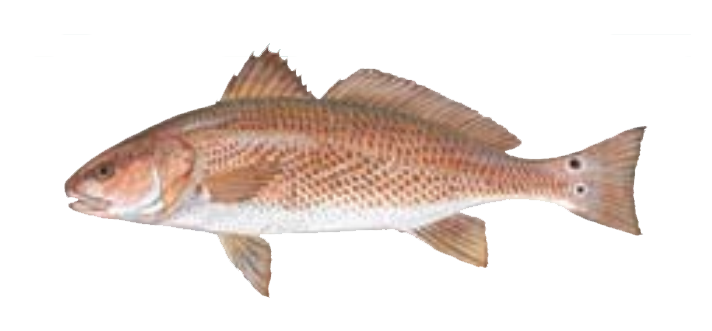
Red drum are abundant in all inshore and shallow coastal waters year-round, but are most abundant in May through October. They can tolerate saltwater as well as freshwater and prefer sand and mud bottoms.
Body iridescent silvery-gray with a copper cast, darker above. One or more ocellated spots present on upper sides from below soft portion of the dorsal fin to the base of the tail fin. Mouth inferior, nearly horizontal, teeth set in bands in both jaws.
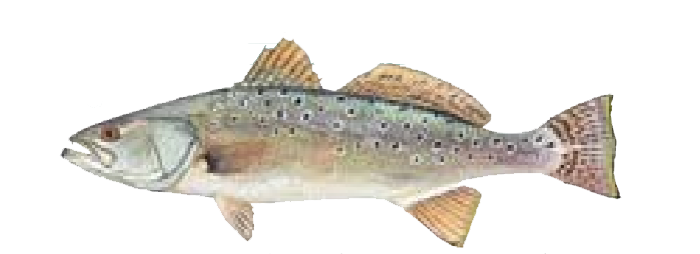
Spotted seatrout are an inshore, bottom-dwelling species inhabiting shallow bays, estuaries, and rivers. They are most abundant in September through July.
Dark gray above with bluish reflections and numerous round black spots irregularly scattered on back and sides, also extending to soft part of dorsal and tail fins. Two large, canine-like teeth at tip of upper jaw, remaining teeth small, and those in lower jaw gradually increasing in size posteriorly. Chin without barbels or pores. Anterior dorsal fin with nine or 10 spines and second dorsal with one spine and 25 to 28 rays, soft portion of dorsal fin without scales.
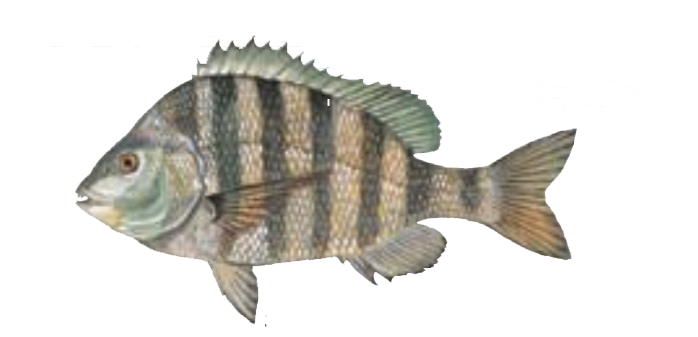
Sheepshead frequent bays and estuaries and areas along the shoreline throughout the year. They commonly enter brackish water in coastal rivers and prefer obstructions such as pilings, piers, and rocks.
Body nearly oval in shape, gray in color with five or six dark vertical bars and one on nape, no dark spot near origin of lateral line. Four broad, incisor-like teeth on each side of the jaw, their edges straight or only slightly notched, several molar-like teeth present. Dorsal fin has 12 spines and 11 soft rays, second anal spine very strong.
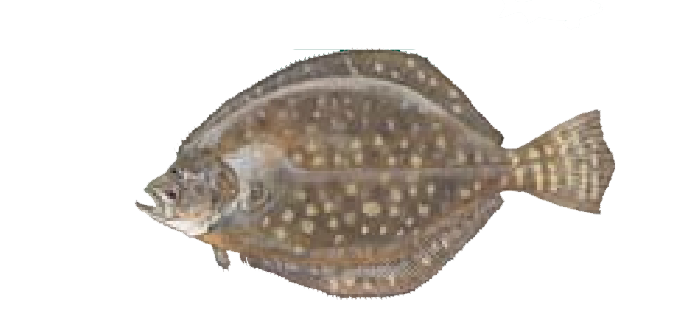
Southern flounder are estuarinedependent bottom fish that commonly inhabit inshore channels, bay mouths, and estuaries year-round. They prefer sandy and live bottom areas around pilings, jetties, oyster bars, and in high current areas.
Body olive-brown in color with diffuse dark spots and blotches, underside of body white. Both eyes located on upper side of body, space between eyes about as wide as eye diameter. Dorsal fin with 80 to 95 rays originating slightly in front of upper eye, pectoral fin with 11 to 13 rays, and anal fin with 63 to 74 rays.
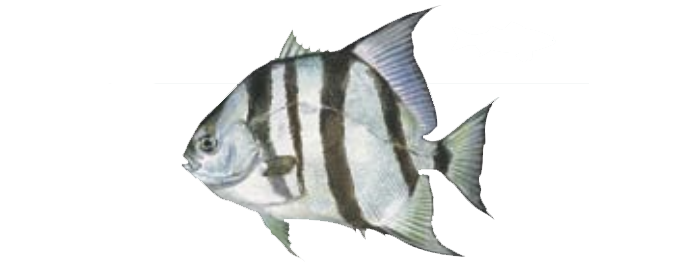
Atlantic spadefish can be found from May through November in oceanic waters nearshore. They are abundant in shallow coastal waters, from sandy beaches to reefs and harbors, and are often found in large schools close to natural or man-made structures. Young Atlantic spadefish can be found swimming at an angle, even parallel to the surface, to disguise themselves as debris.
Body almost as deep as long, body color varies from grayish to yellowish with four to six dark vertical bars. Mouth very small. Anal, tail and second dorsal fins pointed.
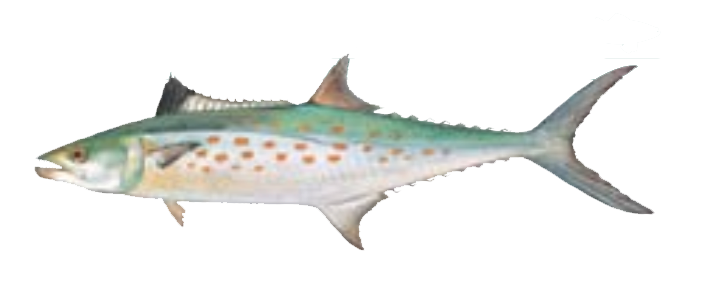
Spanish mackerel are abundant in coastal waters from April through October. They prefer open water but are sometimes found over deep rocky areas and reefs as well as in shallowwater estuaries. They form large, fast-moving schools that migrate great distances along the shore, staying in waters with temperatures above 68 °F.
Back bluish-green, sides silver with numerous yellow to bronze spots and no streaks, anterior portion of the first dorsal black. Lateral line gradually curving down toward caudal peduncle. Two scarcely separated dorsal fins, first dorsal fin with 17 to 19 spines.
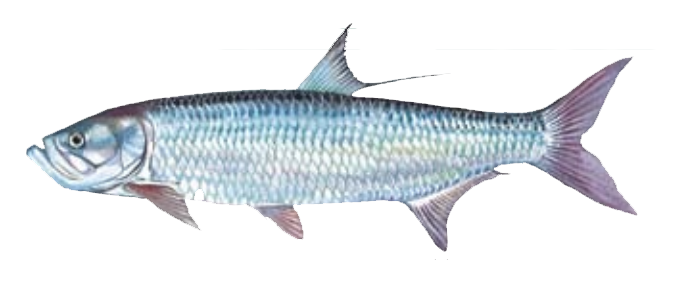
Tarpon avoid colder water and are most abundant in estuaries and inshore waters. However, they are also found in coastal freshwater lakes and rivers, offshore marine waters, and occasionally around reefs
Body moderately deep with large scales, lower jaw projecting. Origin of the dorsal fin near the mid-point of the body, last dorsal fin ray filamentous and very long.
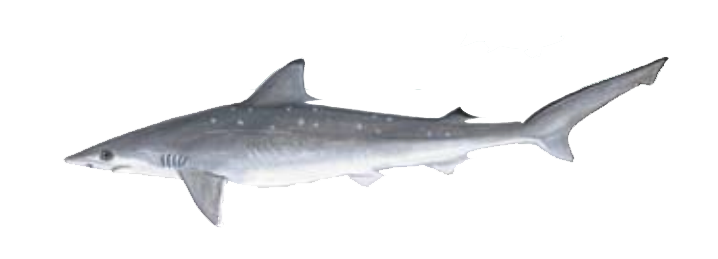
Atlantic sharpnose sharks are usually found in shallow water less than 30 feet deep. They can tolerate brackish water and will inhabit bays, harbors, sounds, river mouths, and estuaries. Atlantic sharpnose sharks form schools based on sex and size.
Sides frequently with a few white spots. First dorsal fin much larger than the second with its origin over the midpoint of the anal fin. No mid-dorsal ridge or lateral keel. Teeth triangular, deeply notched and smooth edged.
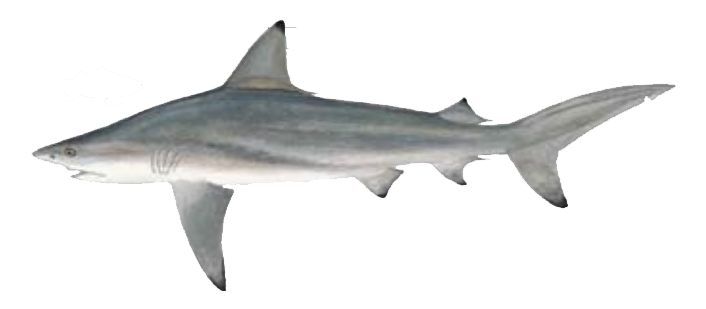
Blacktip sharks can be found both inshore and offshore and prefer clear water. Usually, they live near continental shelves, drop-offs, areas of surf, and near offshore structures. Occasionally, they can be found near river mouths, estuaries, and bays. Adult blacktips school in groups of the same sex.
Conspicuously black-tipped fins, no mid-dorsal ridge, snout long, about equal or slightly less than mouth width. Upper and lower teeth erect and narrow with serrated edges.

Scalloped hammerhead sharks are both an inshore and offshore species. When inshore, they school around live bottom areas and reefs as well as in bays, surf, and tidal shallows. Offshore, they school around the continental shelf and in deep water up to depths of 900 feet. They are rare in waters colder than 72° F.
Body elongated and laterally compressed. Head prominently laterally expanded, “hammer shaped,” anterior margin of head slightly rounded with a shallow but distinct indentation at the midline. Rear margin of eye slightly forward of mouth. First dorsal fin large, its rear margin concave, second dorsal fin small with its rear tip long and slender, extending backward nearly to the precaudal pit. Teeth triangular with smooth-edged cusps.
South Carolina Department of Natural Resources. Guide to South Carolina saltwater fishes. South Carolina State Library, 2003. dc.statelibrary.sc.gov/bitstream/handle/10827/27433/DNR_Guide_to_SC_Saltwater_Fishes_2003.pdf.